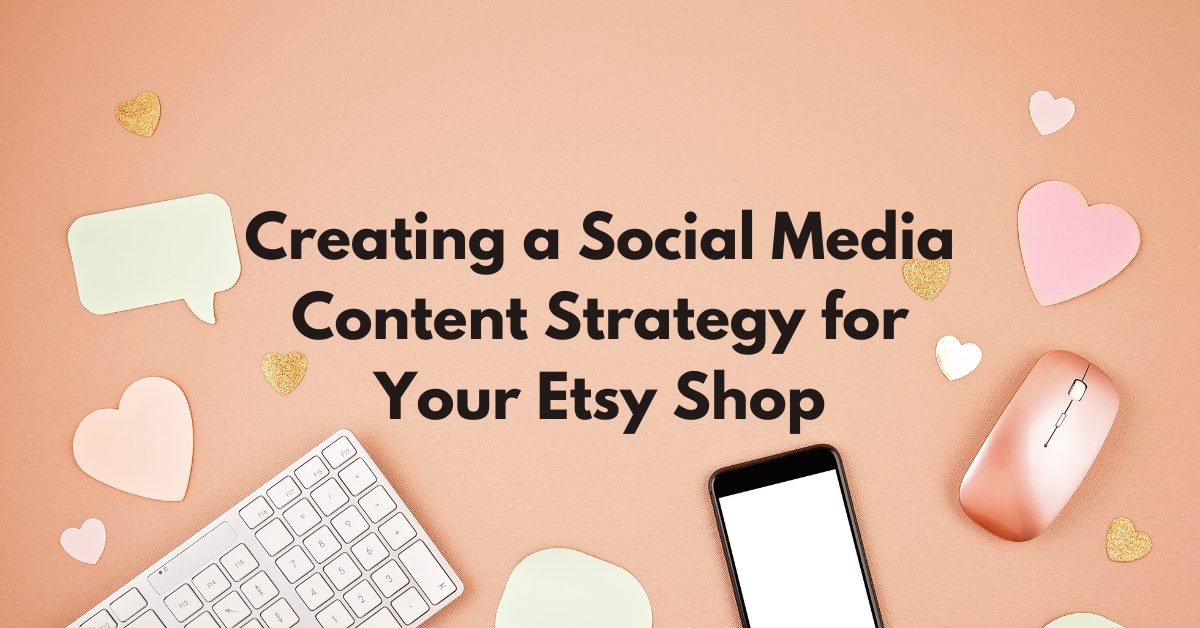When it comes to building a successful Etsy shop, simply listing products isn’t enough. With Etsy being a highly visual marketplace, sellers have an incredible opportunity to connect with audiences through social media. A well-crafted content strategy can help you showcase your brand, increase visibility, and drive traffic to your shop—all while building a loyal customer base. Here’s a step-by-step guide to creating an effective social media content strategy tailored for Etsy sellers.
Table of Contents
1. Define Your Goals and Audience
Before diving into content creation, start by setting clear, measurable goals. Knowing what you want to achieve will guide the type of content you create and where you invest your time. Common goals include increasing followers, driving traffic to your Etsy shop, boosting engagement, or building overall brand awareness. When you have specific objectives, like growing your follower count by 15% in the next month, you can measure your progress and adjust as needed.

Equally important is identifying your target audience. Ask yourself: Who are my ideal customers? What are their interests, needs, and shopping habits? Understanding your audience’s lifestyle and preferences will help you create content that resonates with them and strengthens your brand.
2. Choose the Right Platforms
Choosing the right social media platforms can make or break your content strategy. Each platform attracts different types of audiences, so it’s crucial to focus on the ones that best align with your products and target audience. Here’s a brief overview of the most popular platforms for Etsy sellers:
- Instagram is highly visual and ideal for showing off product images, lifestyle shots, and behind-the-scenes content. It’s a popular choice among Etsy sellers for its focus on aesthetics.
- Pinterest is perfect for sharing visually inspiring content, such as DIY tutorials, mood boards, and product pins. Pinterest users often search for inspiration and gift ideas, making it a strong choice for Etsy sellers.
- TikTok offers a chance to connect with younger audiences through short, engaging videos. Creative demos, package unboxing, or quick “how-it’s-made” videos can work wonders here.
- Facebook remains a versatile option for connecting with diverse audiences and sharing various content types. It’s especially useful for joining or building a community around your brand through groups or pages.
3. Plan Your Content Types
Once you’ve selected the platforms, it’s time to decide on the types of content that will best showcase your brand. Mixing up your content keeps your audience engaged and offers multiple angles to display your products and brand story. Here are a few types of content to consider:
- Product photos and lifestyle shots: Showcase your products in different contexts to highlight their versatility and quality.
- Behind-the-scenes content: Give followers a glimpse into your creative process, showing how your products are made. This builds trust and authenticity.
- Customer testimonials and user-generated content: Share photos and feedback from happy customers. This type of content is powerful for building social proof.
- Educational content: Offer tips or “how-to” content related to your products. For example, if you sell handmade candles, share care tips or ideas for creating a cozy ambiance at home.
- Seasonal or holiday-themed posts: Plan content around major holidays and seasons to keep your feed relevant and timely.
4. Develop a Content Calendar
A content calendar is essential for staying organized and consistent with your social media posts. By planning out your content in advance, you’ll avoid last-minute stress and ensure that you’re covering all the bases, from promotional posts to customer engagement.

Start by using tools like Google Calendar, Trello, or social media scheduling apps to organize your content. Break down your calendar by week or month, and plan posts around key dates, themes, or holidays. For example, if you’re preparing for Black Friday or Christmas, consider scheduling posts that showcase gift guides or special offers in the weeks leading up to these events.
Here are some key tips for managing your content calendar:
- Timing and frequency: Consider posting frequency on each platform based on its norms and your audience’s engagement patterns. Consistency is often more important than quantity.
- Plan for seasonal and event-based content: Don’t miss the chance to create timely posts for holidays like Valentine’s Day, Mother’s Day, or Halloween. Seasonal content can drive engagement and sales.
- Stay flexible: While planning is crucial, be prepared to adapt your calendar as trends or new ideas emerge.
Insight: Koalanda’s Trending Keywords Explorer is a valuable tool for discovering popular search terms on Etsy. It can help you create timely, relevant content that aligns with what buyers are currently interested in.
5. Engage and Measure
Creating content is only one part of the equation—engaging with your audience is just as important. Responding to comments, answering questions, and even liking or commenting on followers’ posts can foster a sense of community and loyalty. Interaction shows that there’s a real person behind the brand, which builds trust and encourages repeat business.

To evaluate the effectiveness of your social media strategy, regularly track your key metrics. Each platform offers insights that reveal how well your content is performing. Here are some basic metrics to monitor:
- Engagement rate: Likes, comments, shares, and saves help you gauge how well your content resonates with followers.
- Website click-throughs: Track how often your social media posts drive traffic to your Etsy shop.
- Follower growth: Steady growth is a good indicator that your content is attracting new audiences.
Use this data to identify what’s working and refine your strategy. For instance, if you notice higher engagement with behind-the-scenes content, you might want to incorporate more of it into your calendar.
Conclusion
Creating a social media content strategy for your Etsy shop doesn’t have to be overwhelming. By defining your goals, choosing the right platforms, planning engaging content, and consistently evaluating your performance, you can build a strategy that not only drives sales but also strengthens your brand.
Starting small and refining over time is the key to success. Remember, a well-thought-out social media presence can be one of your most valuable tools for growth in the competitive Etsy marketplace. Ready to give it a go? Dive into planning, stay consistent, and watch your Etsy shop thrive!






Great tips on creating a social media strategy for Etsy! I love how the article emphasizes setting clear goals and staying consistent with content. Using a content calendar and analyzing performance metrics is such a smart move for long-term success. This is exactly what Etsy shop owners need to stay organized and drive engagement.
Thank you so much, Lindsey! 😊 We’re glad you found the tips helpful. Staying consistent and tracking metrics really does make a difference. Wishing you lots of success with your Etsy shop! 💪✨